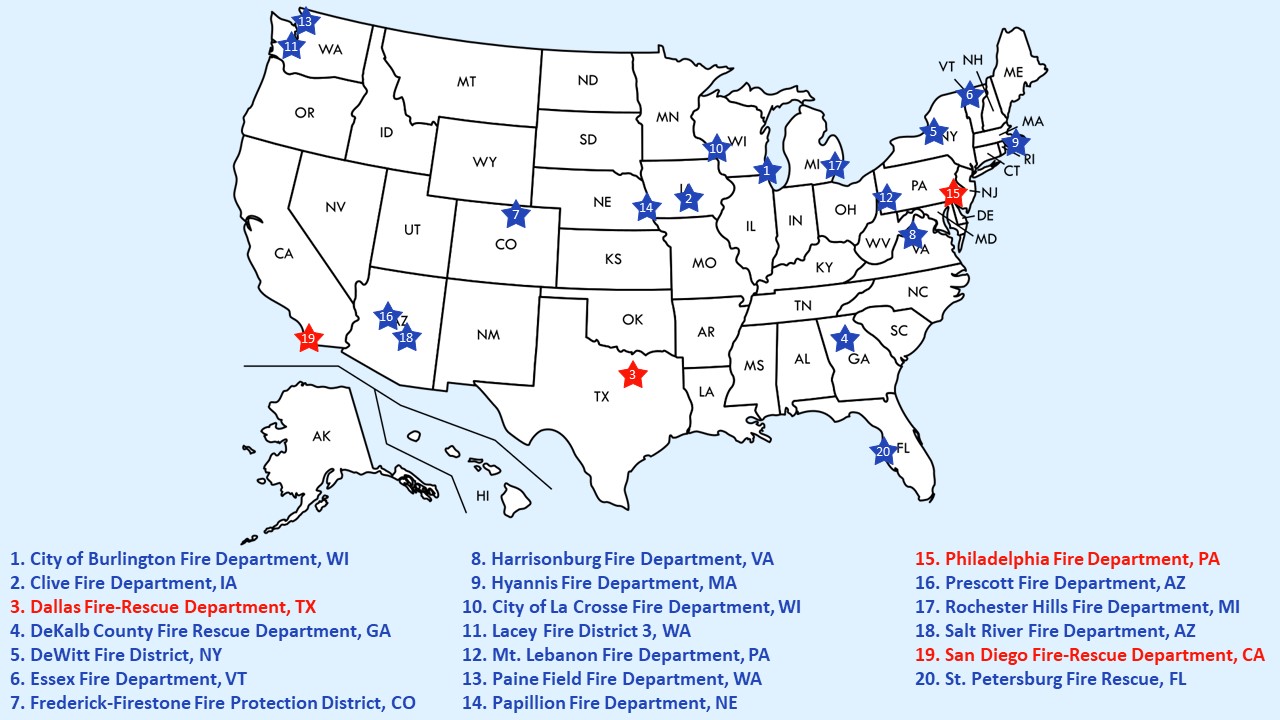COVID-19 RAPID Mental Health Assessment
From 1980 to 2016, the number of calls in the US for fire declined 55%, while the number of calls for EMS increased 320%. This increase represents a continuing trend. On average, 64% of fire department 9-1-1 calls were for medical emergencies. For example, the Philadelphia Fire Department (PFD) responds to 700 to 1,000 EMS calls per day (75% of their total call volume) with only 200 paramedics, half of whom are in service at any given time. These are all pre-COVID-19 trends and numbers. Fire departments can run out of ambulances on any given day under normal conditions, and the FIRST Center's previous research showed that fire-based EMS responders were already concerned about impacts on their mental health. The coronavirus pandemic highlighted a system under incredible stress.
The purpose of the COVID-19 RAPID Mental Health Assessment (RAPID) was to assess firefighter mental health throughout the pandemic across several indicators, including burnout, job satisfaction, work engagement, and PTSD. This enabled tracking of their ability to respond to emergencies and the capacity for their organizations to maintain optimal responsiveness in this unprecedented environment. Results from RAPID will help prepare for the unique resources needed in subsequent waves of the pandemic and for future outbreaks and other disasters.
In developing RAPID, the FIRST Center took two research activities already in the field and quickly expanded them to measure the mental health impact of the coronavirus outbreak on fire-based EMS responders. The first program is the Fire service Organizational Culture of Safety (FOCUS) survey - a previously validated tool that measures organizational safety climate. The second program is the Stress and Violence to fire-based EMS Responders (SAVER) study that developed a Systems-Level Checklist to reduce stress and workplace violence.
Twenty career and volunteer departments were included in RAPID. Among departments who had recently completed a FOCUS assessment between December 2019 and March 2020, a geographically stratified random sample of 17 career and volunteer fire departments was selected to represent the US. Additionally, three fire departments that have been working together as SAVER study sites on the issue of workplace violence, stress, and mental health represented large, metropolitan fire departments with concerningly high EMS call volumes. RAPID looked specifically at the burden on paramedics and EMTs through monthly surveys measuring the impact of the pandemic on their mental health. These repeated measures occurred monthly from May through October of 2020. The results were compared to their baseline measurement that occurred prior to the pandemic to allow for trend analysis and immediate feedback for departments.

Such repeated measures assessment is like the air quality monitoring during 9/11 by several universities. Passive surveillance in the area surrounding the World Trade Center detected unprecedented ambient levels of heavy metals, sulfur, particulate matter, and acidic aerosols, among other harmful and dangerous compounds. This research led to the James Zadroga 9/11 Health and Compensation Act of 2010, paving the way for presumptive legislation that provides compensation for cancer and other diseases prevalent among 9/11 first responders. By initiating RAPID, the FIRST Center conducted similar passive surveillance that will be used to inform policy, behavioral health, and staffing needs of the fire and rescue service, both in regular operations as well as during crisis situations.
Analysis of RAPID data has revealed that departments in the FOCUS arm of the study experienced a shift in work that occurred during the beginning of the pandemic: firefighters were doing more EMS work. This change likely contributed to an increase in emotional exhaustion and the desire to leave the profession altogether.
Among the metropolitan departments, results showed a decrease in overall wellbeing. Departments showed high levels of emotional exhaustion, leading to decreased morale, increased risk for depression, and a lack of adherence to safety protocols. However, it was found that safety climate--the shared perceptions of employees regarding their organization's safety protocols--can safeguard morale and limit the risk for depression, even when first responders are burnt out.
These results indicate that, through empathetically communicating the importance of on-the-job safety and through maintaining behavioral health resources, department safety climate can be improved and mental health concerns can be addressed. This will uphold first responder safety and wellbeing in fire and rescue departments during crises like a global pandemic.
Ongoing analysis of RAPID data shows increases in burnout, anxiety, depression, and intention to leave the profession. It also shows decreases in job satisfaction, work engagement, and organizational support. As expected, there is variability: some departments had significant change, and some had little. But in most of these departments, the absolute level of burnout, anxiety, and depression are concerningly high. Some of the top responses to how the pandemic affected first responders included: exhaustion or tiredness, stress from staying up-to-date on best practices, feelings of being overwhelmed, and fear of spreading the virus to family and friends. RAPID departments have already used these preliminary findings to advocate for much-needed mental health resources.
READ RAPID DEPARTMENT SUCCESS STORIES
We also conducted interviews and focus groups with fire service members of varying rank from 15 of these fire and rescue service departments in September and October of 2020. Analysis of these sessions revealed that the pandemic thrust various job demands on firefighters and EMS responders, ranging from changes to daily operations aimed at limiting virus transmission to COVID-19 related restrictions. These changes caused severe mental fatigue and work-life balance issues, with first responders being isolated from their families as a safety precaution or seeing their families less due to working longer shifts. Departments provided resources to address these demands, but firefighters perceived that greater emphasis was places on addressing job demands.
These findings let first responders tell their stories of how the pandemic affected their work and their lives. This underscores the impact that having access to key resources has on the safety culture within fire departments and on the mental well-being of the individual responder, both during periods of normalcy and of crisis.